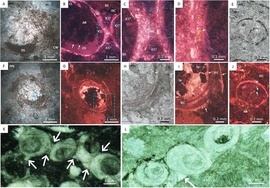Trying to explain the formation of the Ediacaran fossil Cloudina.
[sciencythoughts.blogspot.com]
Cloudina, and similar fossils such as Conotubus, Saarina, Multiconotubus, Costatubus, Zuunia, and Rajatubulus (collectively Cloudinomorphs) first appeared in the Latest Ediacaran, around 550 million years ago, and persisted into the Early Cambrian, vanishing around 520 million years ago. These fossils have a funnel-in-funnel organisation without transverse structures, and may be straight or sinuous. Some of these fossils are purely organic, others are mineralised, preserved as calcite, phosphate, limonite/pyrite, or silica. Many (but not all) of these fossils are phosphatised, with there being no clear relationship between phosphatisation and mineralisation.

Enjoy being online again!
Welcome to the community of good people who base their values on evidence and appreciate civil discourse - the social network you will enjoy.Create your free account
1 comment
Feel free to reply to any comment by clicking the "Reply" button.At first I thought those were photographs of Uranus, as opposed to Myanus.
It's times like these I regret never taking geology, I do like shiny things.
Recent Visitors 13
Photos 292 More
Posted by JoeBKite-like structures in the western Sahara Desert.
Posted by TriphidAn Aussie Indigenous Message Stick.
Posted by TriphidIndigenous Australian Aboriginal Rock art dated somewhere between 20 and 30 thousand years old.
Posted by TriphidIndigenous Australian Aboriginal Rock art dated somewhere between 20 and 30 thousand years old.
Posted by TriphidIndigenous Australian Aboriginal Rock art dated somewhere between 20 and 30 thousand years old.
Posted by TriphidIndigenous Australian Aboriginal Rock art dated somewhere between 20 and 30 thousand years old.
Posted by JoeBDortoka vremiri: A new species of Dortokid Turtle from the Late Cretaceous of the Hațeg Basin, Romania.
Posted by JoeBThe Cabeço da Amoreira burial: An Early Modern Era West African buried in a Mesolithic shell midden in Portugal.
Posted by JoeBMusivavis amabilis: A new species of Enantiornithine Bird from the Early Cretaceous Jehol Biota of northeastern China.
Posted by JoeBTorosaurus in Canada.
Posted by JoeBStone tools from the Borselan Rock Shelter, in the Binalud Mountains of northeastern Iran.
Posted by JoeBDating the Lantian Biota.
Posted by JoeBBashanosaurus primitivus: A new species of Stegosaur from the Middle Jurassic of Chongqing Municipality, China.
Posted by JoeBDetermining the time of year when the Chicxulub Impactor fell.
Posted by JoeBSão Tomé and Príncipe: Possibly the last country on Earth never to have been visited by a working archaeologist.
Posted by JoeBMambawakale ruhuhu: A new species of Pseudosuchian Archosaur from the Middle Triassic Manda Beds of Tanzania.
Members 658Top
Moderator
Related Groups
Religion of Science & Higher Consciousness
77 members
Political Posts, Articles and Memes
169 members
"I was blocked!?" Group
95 members
Conservative Bashers And Progressive Pushers
136 members
Trump Pinata
1142 members
FreeThinkers
2693 members
Progressives, Socialists, and Black/Palestinian Lives Matter
2460 members







